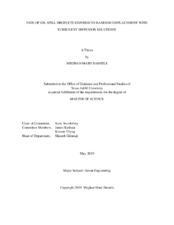| dc.description.abstract | Shipping trade routes are seeing an influx of traffic due to the increase in American trade and the ice melt occurring in the Arctic. The global warming effect on the Arctic’s ice has peaked interest for possible trade routes and a heightened source of oil and gas development. The need for oil spill models that include variable environmental conditions, such as those in the Arctic, is significant because of this increase in marine operations and increased risk for an oil spill.
The Texas A&M Oil Spill Calculator includes Lagrangian particle tracking for bubble or droplet time-average trajectory prediction through the water column that includes a combination of fate processes. These fate processes include dissolution, heat transfer, and advection equations. In this thesis, the oil spill calculator was modified to incorporate a random displacement model and empirical relationships for vertical turbulent diffusivity as a function of density gradient and free-surface wind stress to better predict oil droplet fate in shallow water. Surface wind is a proven cause of turbulent diffusivity, specifically in the uppermost layers of the ocean. Therefore, an empirical relationship for wind and turbulent diffusion is applied to the mixed layer depths and the random displacement solution for diffusion is applied throughout the model domain.
To test the new model algorithms in the Texas A&M Oil Spill Calculator, we apply the model to scenarios of oil blowouts and subsea spills in Alaska with varying environmental conditions and send the nearfield output to the General NOAA Operational Modeling Environment tool which further predicts the farfield trajectory. This developed modelling method presents an accurate simulation for hazardous spill response and emergency cleanup efforts in adverse weather conditions. | en |


